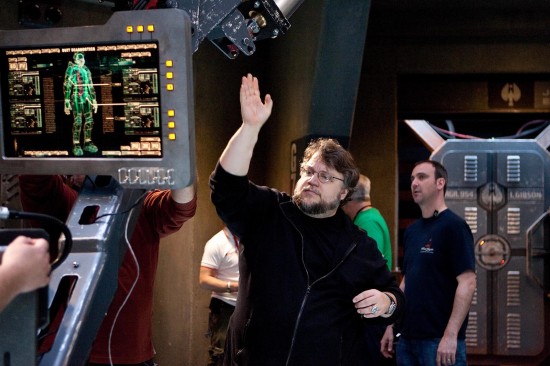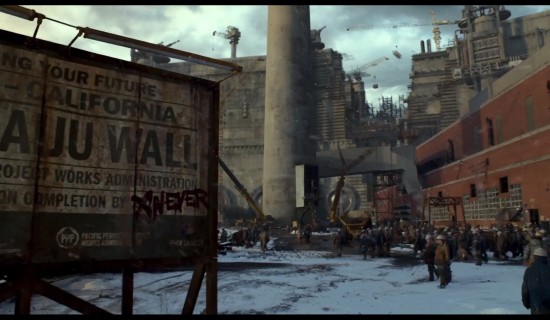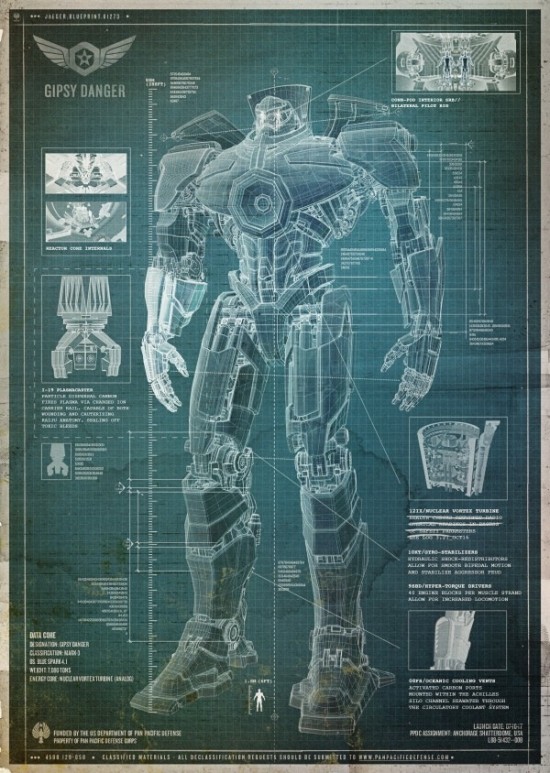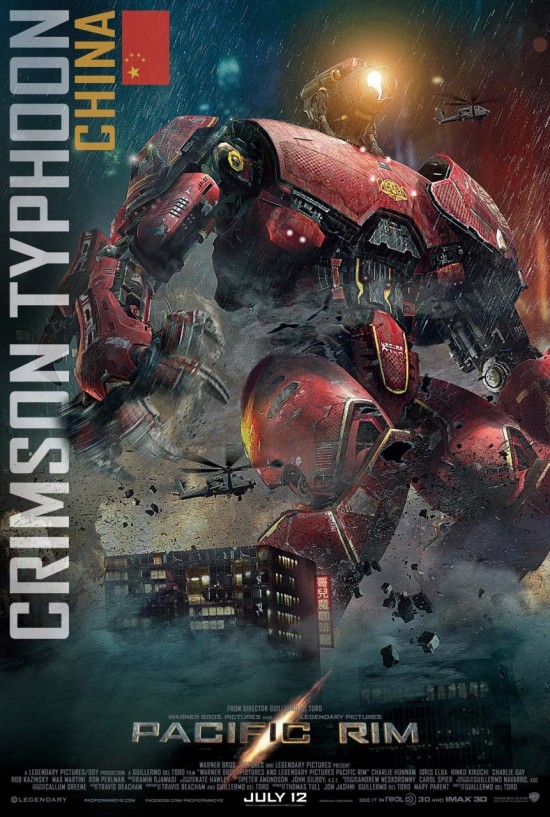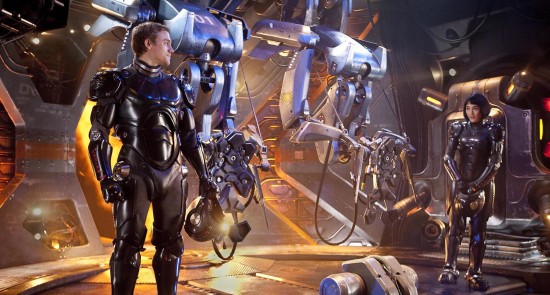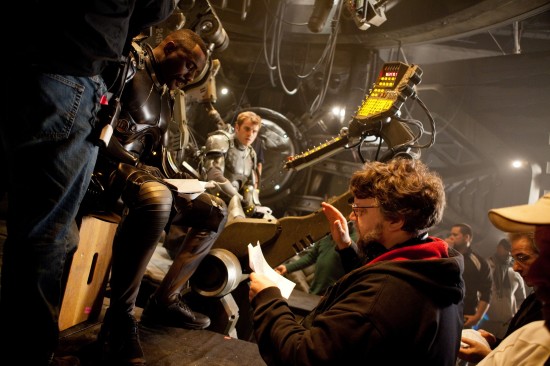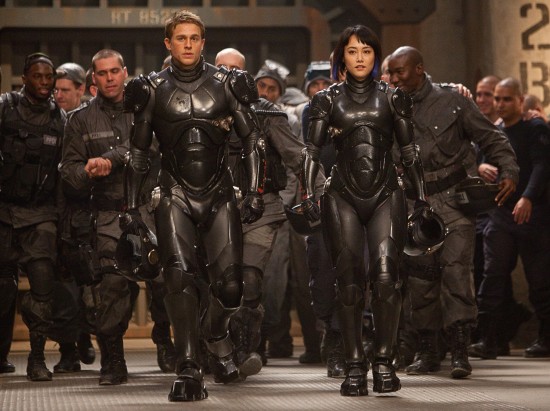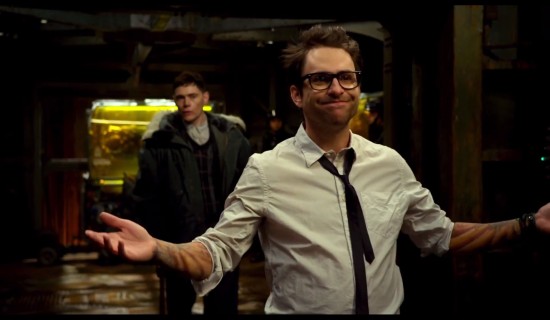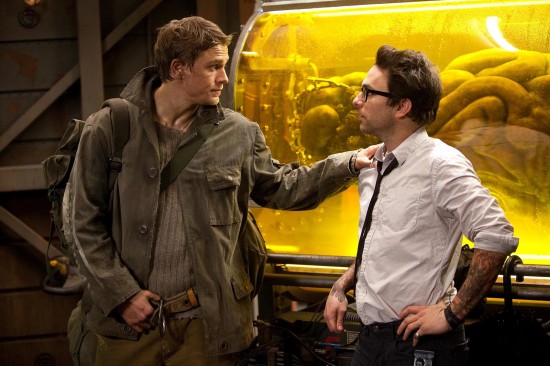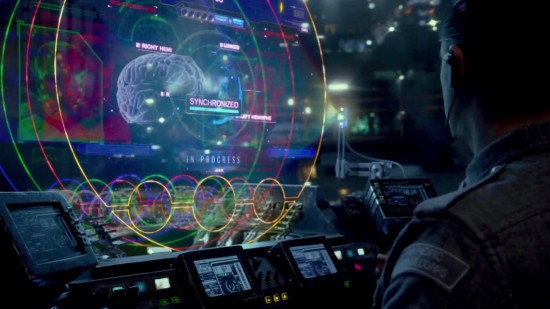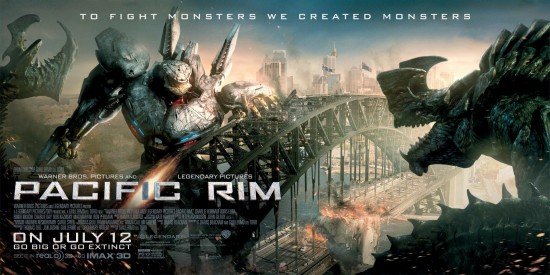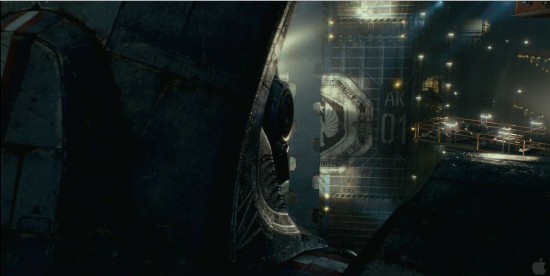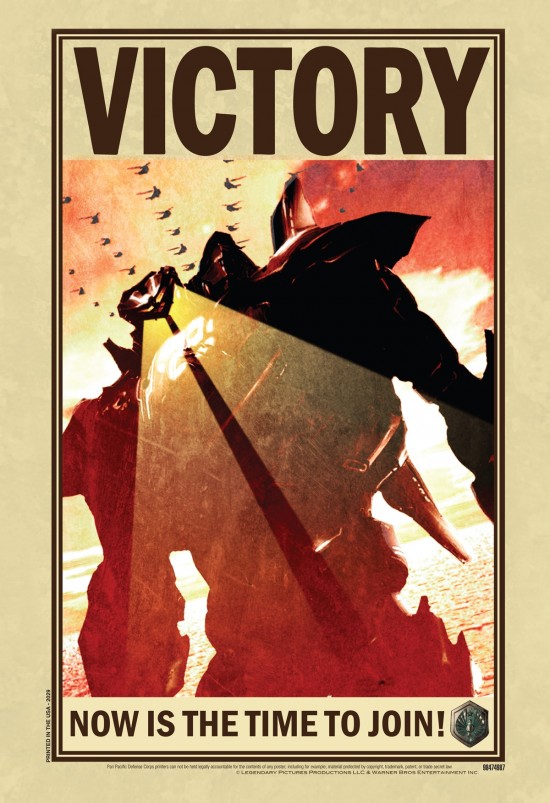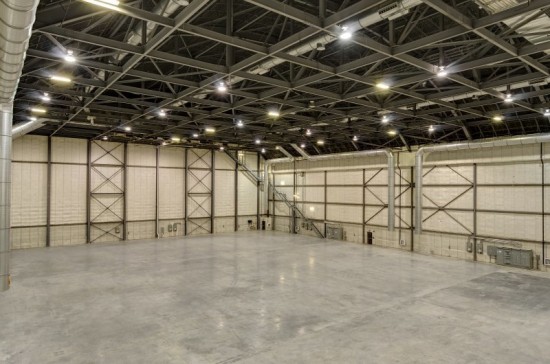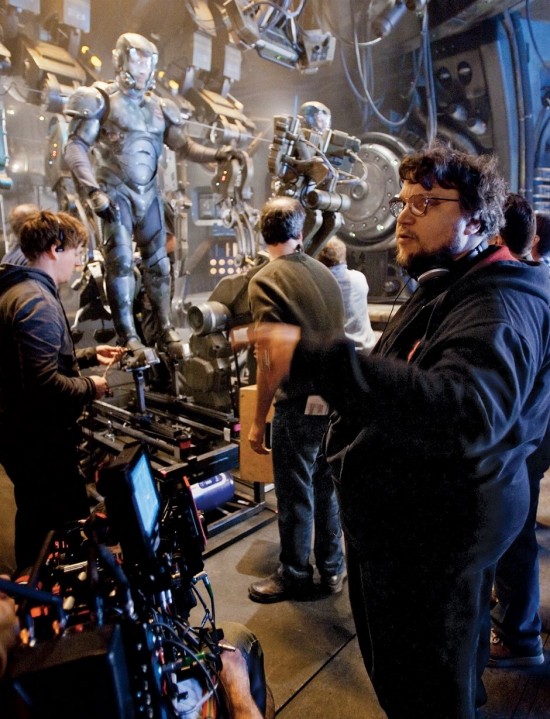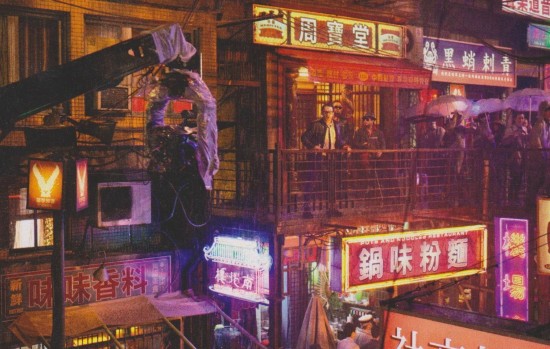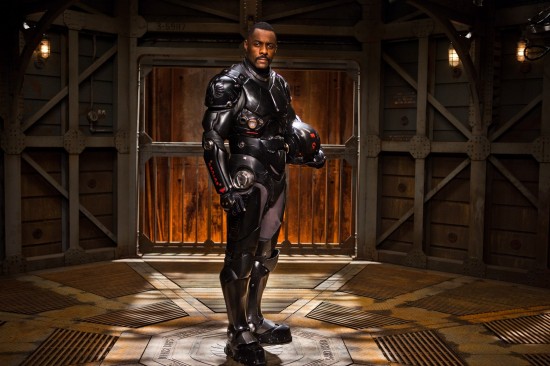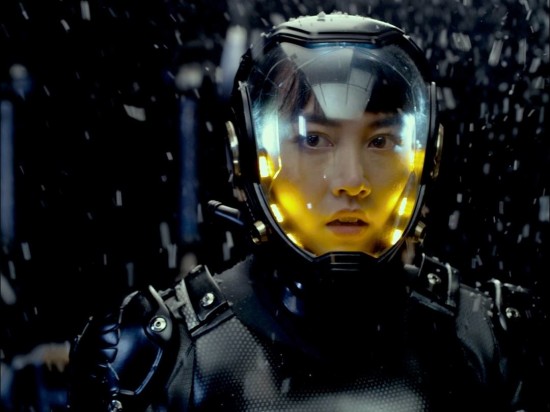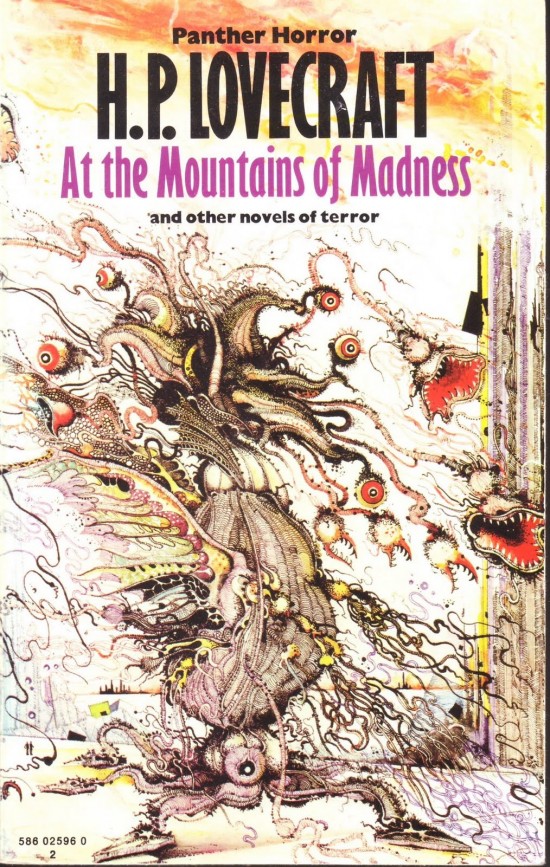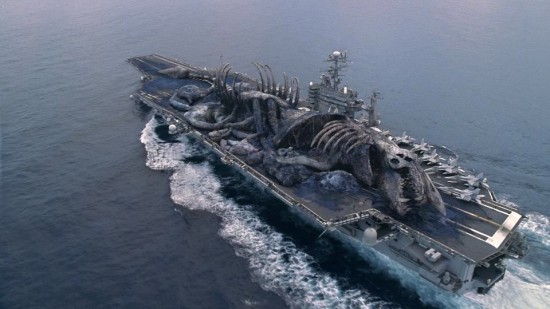80 Things We Learned On The Set Of Guillermo Del Toro's 'Pacific Rim'
I visited the Toronto set of Guillermo del Toro's Pacific Rim on March 28th 2012. While on set, we toured the art room, watched filming, saw a bunch of the sets, and interviewed Guillermo and some of the cast. You'll be able to read those transcripts over the next week on the site, but after the jump you can read a writeup of over 80 things I learned on set (3,685 words worth, and this is one really worth reading) alongside a video blog I recorded with Steve from Collider giving our thoughts on what we had seen.
Video Blog:
80 Things We Learned On The Set of Guillermo del Toro's 'Pacific Rim':
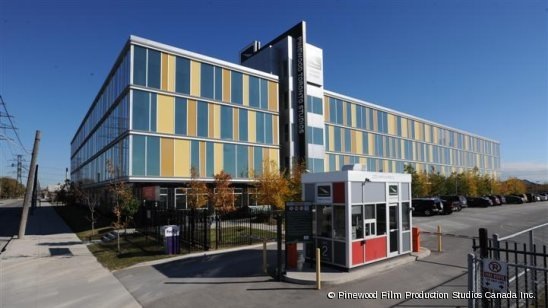 Pacific Rim was shot at Pinewoood Studios in Toronto, which is where the remakes for Total Recall and The Thing were also filmed. All 8 stages in the studio were used for the entire production. 101 sets were created for the film. One hallway in the production office features posters from every one of Guillermo's movies including different variants.
Pacific Rim was shot at Pinewoood Studios in Toronto, which is where the remakes for Total Recall and The Thing were also filmed. All 8 stages in the studio were used for the entire production. 101 sets were created for the film. One hallway in the production office features posters from every one of Guillermo's movies including different variants.
The film was shot over 103 days on the first unit, and we visited on day 83. They also filmed 56 splinter unit days. Shooting began on November 14th 2011, a whopping 606 days before the July 12th, 2013 release date.
Only 3 real life locations are being used, but even on those location shoots they added so much production design to it that you wouldn't really recognize the real location. The three locations are a Toronto street turned into Hong Kong, an old hydro planet called The Hearn which has been turned into the Alaska construction site, and the beach from the beginning of the film where Gypsy Danger fights a sea battle and crashes. For that sequence, they constructed a piece of a robot head which was 30 feet by 30 feet and that's only still a half of one side of the Jaeger's head.
When we were on set, they were confident that the movie would be a 2D release telling us that it was highly unlikely it will be post-converted. Guillermo told us that he didn't want to do 3D because large scale battles shot far away don't present much depth. He thought that if you tried to force depth into those kind of sequences, it would look like miniatures.
Del Toro decided against shooting the movie in 48 frames per second because he thinks the experience only enhances 3D films, and he didn't plan on releasing Pacific Rim in 3D.
At the time, del Toro was still considering shooting one of the final sequences in full IMAX. The cockpit of the robots is so confined that he was very hesitant to shoot IMAX in these sequences. The sequence they were considering shooting on IMAX was "perfectly suited for the format." The visual effects for the IMAX sequence would've had to be rendered at 4k. Traditionally CG is rendered at 2k. More processing time, more rendering time, more hard drive space, and most importantly the extra detail required to make it look more real. I don't believe this actually happened. Guillermo instead ended up seeing a post converted 3D test and loved it enough to change his mind.
Guillermo del Toro shot both A and B unit, often spending 20 hours a day working on the movie. Ron Pearlman thinks that Guillermo is "the closest thing we have to Leonardo Da Vinci" today, and he feels like a complete slacker when in del Toro's presence. He says Guillermo will do a 12 our day and then edit the movie when production stops. Guillermo admits he never sleeps more than 4 hours a night.
About 1/6th of the film is created entirely digitally, and the film features between 1,600 and 1,700 visual effects shots. ILM are doing the effects for essentially half the price, and able to do that because Guillermo is providing footage so early so that the animators can work on normal hours instead of chasing a deadline with overtime hours later in the production.
Guillermo had to edit while he shoots to approve the shots he needs to send to ILM. He edits every Saturday, and shoots "hands pressing buttons" (ie insert shots) on Sundays. He also edits on his lunch breaks.
This is the first digital movie Guillermo has ever made. The movie is perfectly suited for shooting digitally. Guillermo says he couldn't have done Devil's Backbone with digital, but this film's aesthetic calls for saturated colors, which benefit from the high definition look.
This movie also has more dialogue than any of his other movies. Guillermo says the key is to blast through dialogue with drama and make it compelling.
Guelllimo's office is located in the art department and has a shelf with toys, including an Akira figure and bike, Pixar's Tin Toy and a couple funny statues from The Simpsons and The Flintstones. There are some Godzilla toys and mechs to inspire the design team. A lot of books. While the collection might look massive in most geek's homes, they are only materials that del Toro has recently bought. None of the materials have been brought here from del Toro's home, all of the collectibles were acquired by del Toro while in production in Toronto.
Every time they make a maquette for any of his productions, Guillermo personally pays to have a second maquette made so that he can personally own one in his collection. This is part of his contract.
The working title for the movie was "Still Seas." Signs around the studio and even production artwork in the offices featured the fake working title. It was hard to find a mention of "Pacific Rim" anywhere, even on the schedules and paperwork.
The backstory is that in 2013, a inter-dimensional portal opens in the sea unleashing massive monsters. The Jaegers were designed by a United Nations-style partnership between all the coastal cities/countries in an effort to kill the monsters and protect the cities. This story takes place in 2025, when the monsters have begun appearing more frequently. The world is coming to an end, and they're leading the last fights to keep humanity alive. In Alaska they are trying to build a 300 foot wall across the Pacific Coast as the government is starting to believe that Jaegers aren't working as a solution.
15 artists worked on the production.
The mech robots are called Jaegers, and are 25 stories high and require at least two pilots to function. look like a mix of Transformers and more practical Real Steel-style bots, but 250 to 280 feet tall. Striker Eureka is the largest.
We got to watch the ILM audition tape which was put together in just 9 weeks. The short clip features a massive mech robot fighting with a Kaiju, knocking through buildings in a big city. John knoll worked on the test footage.
Guillermo wanted the robots to feel and move more mechanically, like robots, which is why they chose not to use performance capture.
Gipsy Danger is the name of the hero robot — A Mark III, the oldest of the robots in the film.
Gipsy Danger is armed with a plasma gun and a sword.
Kyoto Tango, Crimson Typhoon, Striker Eureka, Tacit Ronin, and Horizon Brave are the other major Jaegers.
Crimson is a red robot with three arms and three pilots.
Each robot his different fighting styles.
The robots sport markings on their exterior armor, indicating how many monsters they has killed and other stats.
Pilots inside the Jaegers are hooked in through the Conn-Pod. They control the Jaeger through movements and a shared neural bridge between the two pilots. The pilots have a 3d projected HUD inside the robots before the windshield looking out to the outside world.
The Conn-Pods are located inside the head of all of the mechs, except for Gipsy Danger, which has the conn-pod located in the chest. The inside of each pod has a very different look and feel, so when they cut between the different robots you'll know which one you are inside. For instance, Striker has a green army look. The Russian Conn-Pod looks like an old battleship.
The Conn Pod in the Crimson Typhoon, the Chinese Jaeger, is more modern looking, red and black colored, with room for three pilots. The Chinese pilots are played by three identical Chinese triplets. They are called the Wei Tang Clan.
The Conn Pods are practically built sets, where most of the robot exteriors are computer generated. The robots are so massive they couldn't build them practically. During some scenes you'll see a 15 foot tall piece of the robot's heel. Whenever a Jaeger is on screen with an actor, a piece of the robotics constructed to extend into the computer generated Jaeger (set/prop extension). The Conn Pod sets are 30 feet by 25 feet.
Del Toro wanted to bring the language of World War II bombers and oil tankers into the visuals of the Conn Pods. He wanted the sets to have scratches and wear, and feel as real as possible.
Around the world there are underground bunkers called Anti-Kaiju refuges where people can hide when the Kaiju alarm goes off. These areas are very crowded and claustrophobic.
Del Toro wanted the Kaiju to always feel like a force of nature, unrelenting and massive.
Guillermo didn't want to do the story of partners who hated each other that are forced to be together. He instead wanted to tell the story of all the world coming together, even though all of them have great differences.
He was considering Charlie Hunnam for Hellboy 2, even going as far as doing screentests. But he decided to go a different way with the casting at the time.
Charlie Day's character Dr. Newton Geiszler works for a Pan Pacific group studying the monsters' organs. Newt is a comic relief character but always set in real dramatic situations. He is sort of the "Everyman" in the movie. Newt goes on the streets to find Hannibal (played by Ron Perlman), to get his hands on a black-market Kaiju brain, and finds himself in the middle of the action. He is obsessed with trying to share a mind space with one of the Kaiju, much in the same way the pilots share a mind space to operate the Robots, to experience what they see.
He is a nerdy scientist rebelling against the look of "the nerdy scientist" instead trying for a more rock and roll vibe which "both suits him and doesn't suit him." His costume gives you a glimpse into who he wants to be rather than who he is. For instance his leather jacket and silver skull pinky ring.
Guillermo is a huge fan of It's Always Sunny, which is why he cast Charlie Day in the film. Day says he is a huge fan of Pan's Labyrinth, so they hit it off. Day joked on set that the budget for any one of the Pacific Rim sets is probably more money then a season of It's Always Sunny. He was amazed at the detail and says if you find a broken car on a street set, you'll probably find a receipt in the car from one of the storefronts on the set.
Charlie Day says that Guillermo knows more movies and shots than any other director he's ever worked with. He knows how to use the cinematics in a way that makes him a true visual artist.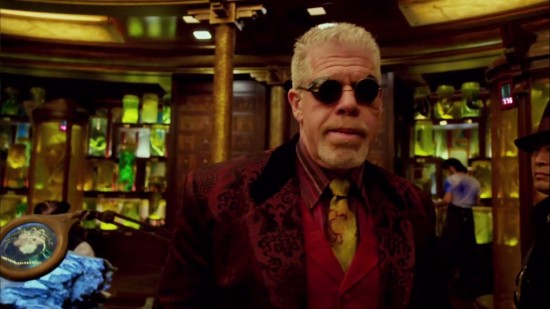 Ron Perlman's character Hannibal Chau is the head of a group of scavengers who get to Kaiju remains first and sell pieces of the corpses on the black market. He has a contract — the sole contract — with the government to get the kaiju parts after they are done with them. He's in it for profit, not science. Kaiju bone powder apparently has a much better effect than Viagra, making it very valuable. Hannibal is a bit of a collector, who likes to surround himself with artifacts from endangered species, and wears fine clothes and design. He's got a big scar on the right side of his face, above and below his eye. His gold tie has traditional asian red dragons on it. Gold jewelry and watch, and gold plated shoes.
Ron Perlman's character Hannibal Chau is the head of a group of scavengers who get to Kaiju remains first and sell pieces of the corpses on the black market. He has a contract — the sole contract — with the government to get the kaiju parts after they are done with them. He's in it for profit, not science. Kaiju bone powder apparently has a much better effect than Viagra, making it very valuable. Hannibal is a bit of a collector, who likes to surround himself with artifacts from endangered species, and wears fine clothes and design. He's got a big scar on the right side of his face, above and below his eye. His gold tie has traditional asian red dragons on it. Gold jewelry and watch, and gold plated shoes.
Hannibal Chau was designed to be played by an actor of another ethnicity, but del Toro had the idea to rework the character for Perlman.
The actor says he's playing the character "big" and "very theatrically".
Of all the sets, the most fine detail went into Hannibal Chau's secret lab set. There are lots of animatronic monster pieces, custom constructed aquarium structures holding Kaiju pieces. Guillermo has described the set as "the jewelry box," from the film's inception. Ron notes that there is always a set on a Guillermo del Toro movie with dissected creatures created for science, collecting, or both.
Four-foot long alien insect creatures called Roleypolly are found on the dead Kaiju; they're parasites that live off the monsters. The insects are created with a combination of computer effects and full-size puppets which are robotically controlled.
The future looks much like our world, no flying cars or super advanced technology other than the robots. The world isn't very futuristic because resources have been focused on trying to stop the monsters since a couple years after the first attack. They looked at how the world would react to these monster attacks realistically, how the world would become a ration-based economy with the prices of food skyrocketing. Oceanside property becomes for the poor. Inland for the rich.
The machinery of the pilots are based on existing technology but the specifics are not always explained. Guillermo has jokingly coined the word "bullshit-tanium" for the instances when they must come up with bullshit reasons to try to explain everything, even if it's not possible — it just needs to pass.
Kaiju have all different shapes and sizes, but often look reptilian. Slattern has a hammerhead shaped head and large spiked back, with a tail that splits in three. Another monster has a sharp knife shaped head. Onibaba is a more crustacean styled creature. One looks more like a crocodile and moves on all fours. Leatherback is a more brutish King Kong-looking reptile monster.
The choice of making the monsters 240 feet tall is to give them size, but not completely dwarf everything around them. That gives us things to compare the scale of the monsters against. The idea is to make the action sequences feel more real and grounded in the world we know.
The Jaegers are housed in Shatterdomes in various countries. Most of the movie takes place in the Shatterdome in Hong Kong. The top of the dome opens up like petals on a flower.
The bridge is called the Loccent. Sets are made mostly of concrete, using blue tones. The whole environment is very tactile and real with a holographic screen every once in a while. Nothing frivolous exists in this world anymore.
Propaganda posters are all around the production office; they'll be seen in the film and used in the marketing campaign. These posters are trying to convince people that the war against the Kaiju is being won, even though it might be dire times.
Beltcher Street features part of a Kaiju skeleton that has been there from the early attacks. Residents have rebuilt their homes and buildings around and inside the bones. It is now a part of the buildings.
In the production office space, a set of long hallways are marked at every 10 feet, giving the people working on the film a real sense of scale so that when they are talking about something being 100 feet long, they have a real sense of how long that really is.
When I visited the set, Stage 2 was housing the beginning of what will be the insides of a Kauji's organs, a 50 foot by 20 foot construction.
Stage 4 of Pinewood Studios in Toronto is referred to as mega stage as it is the largest purpose-built stage in North America. When I was visiting, Stage 4 was housing a couple sets, the exterior and interior of the Kaiju refuge in Hong Kong. And the inside is a large brick tunnel which was destroyed.
On stage 7 we saw them constructing a fishing ship on a small gimbal; the ship finds itself in the middle of a battle between a Kaiju and a Jaeger outside Alaska. It took over a month to construct, and they will shoot the ship for maybe a day, and will appear in the film for less than a minute of screen time.
On Stage 8A, they constructed the 2013 Jaeger that we see at the beginning of the movie. It is destroyed, one of the ellipticals has been ripped out, probably by a Kaiju.
In stage 8B, we saw the Russian Conn Pod being constructed on top of a tall gimbal which allows the production to tilt the set to a 45 degree angle. The set is 70,000 pounds. 400 horsepower hydraulics move the set. In the old days, this would have controlled by ten puppeteers working in sync to control with joysticks, but the fx supervisor demonstrated how they use a miniature replica of the gimbal, which is 2 feet by 2 feet, manipulating the robotic miniature model to control the set.
It takes close to two hours to put the actors in wardrobe and hook them into the Conn Pod elliptical.
The Hong Kong Incident Zone set was a huge set of mass destruction. Among the rubble is a four-stall bathroom which has been ripped out of a skyscraper building; overturned cars; a street of storefronts torn apart; pieces of flickering neon; air conditioning units; and a double-decker bus which has almost been ripped in two. The central point features the 50 foot wide top of a skyscraper, featuring a huge sign for the Hong Kong Reserve Financial, completely ripped off and sitting in the rubble. Street lights and support beams are bent and ripped apart. A blue wheelbarrow carrying blue pieces of Kaiju organs. A massive hole in the ground is fifteen feet deep. This is where the anti-Kaiju refuge area that we saw on a different set would be placed.
One of the art directors said this is the first time they dressed a set using forklifts and jackhammers. Much of the set is made with real materials, unlike most sets.
The set was built as a non destroyed Hong Kong, then destroyed and redressed to play as a different area, post-monster battle. The Hong Kong set was used as four different streets and sets, with the placement and dressing of elements changed each time.
Legacy effects (formerly Stan Winston's company) created the practical effects on the film.
They had to build different helmets/suits for the different Jaeger pilot groups. The Chinese jaeger helmets are dark red and have a big star as part of the visor. The Russian helmets look a bit more steampunk, brown leather material mixed with a bronze/gold-like metal, with eye holes like camera lenses. The helmets are constructed with custom LED lights and a communication system which allows actors to hear their lines and the crew. The helmets also have a working fan system built in.
The screenplay has 40 pages of suit work, and Legacy constructed 34 suits for the movie.
Legacy also constructed stunt masks for the stunt performers, which feature a real-looking mask of the star actor's face. Since the helmets feature a wide open face, this helps complete the effect that the actors are doing the stunts without expensive facial replacement. We've seen these kind of latex masks before on Terminator Salvation.
Guillermo and screenwriter Travis Beacham went through 15 drafts of the script.
Del Toro wanted this film to have intense battles and feel really visceral while keeping a marketable rating. There isn't much gore and the Kaiju blood is blue, which doesn't mean much to the MPAA.
Guillermo says that At the Mountains of Madness and The Hobbit were great training grounds for this movie, which helped them prep this fast and get going quickly. del Toro came on board after hearing just the pitch alone, and was originally attached as a producer when he was prepping to direct Mountains. When Mountains was dropped he quickly jumped on this project.
Tom Cruise was originally considering this project after Mountains failed to move forward. But he ended up going with other projects instead. (From the timeline, it looks like those projects were Jack Reacher and Oblivion).
Guillermo said he would gladly revisit these characters and this world, but he has no idea if there will be a sequel.
We will see glimpses of the Antiverse, which is the other side of the breach from which the Kaiju emerge. It's a different dimension with a completely different gravity and sense of time. It has a fantastic look, with very polarized color.
We won't learn the monsters' entire game plan. Guillermo del Toro believed that if you know too much about their plan, even in the end, the excitement goes away. We will learn why the Kaiju are coming to our universe and the answer is terrifying. But answering that question poses new questions. There are only a few minutes in the movie featuring the Antiverse, so a lot of mystery remains.
What do they do with a monster's body when they kill it? What happens when a Kaiju poops? We will find the answers to these questions.
The speed of the robots is governed a bit by gravity and a bit by the action. Each robot has a different style of movement.
Del Toro didn't want the monsters in each country to be married to a landmark, for instance a monster attacks Paris and attacks the Eiffel tower. Although, as you've seen in the marketing, one Kaiju does violence to the Golden Gate Bridge in San Francisco.

